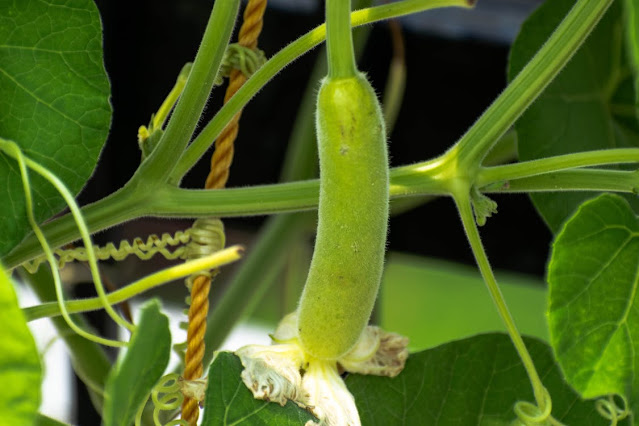Cultivation of Bottle Gourd ( Lauki )
Bottle gourd (Lagenaria siceraria ) belongs to the Cucurbitaceae family and it is a very important crop in India. The fruits in the green stage and leaves with stem are used as vegetables. The hard shell of the fruit is used for different purposes.
Origin;
Bottle gourd has originated from Africa. It has spread from Africa to other warm countries.
Abu (Sanskrit); lauki or ghia (Hindi); dudhi or tumbadi (Gujarati); sorakkai (Tamil); chorakkaurdu (Malayalam); and ghiya (Urdu)
A hot and moist climate is favorable for its cultivation. It can not withstand frost. The plant can tolerate low temperature but under the extremely cold conditions, its growth retarded and frost may kill the bottle gourd plant.
Soil & its preparation
Bottle gourd can be grown in any type of soil. But sandy loam soils are best suited for its cultivation. The suitable pH range for this crop lies between the 6 -7 but some of the varieties may tolerate alkaline condition up the 8.
The land should be prepared thoroughly by five to six ploughings.
|
Variety |
Developed by |
Characteristics |
|
Arka Bahar |
IIHR Banglore |
Fruits straight without crookneck medium-sized each weighing 1.0 kg at marketable stage, fruit light green, and shining, yield 40-50 t/ha. |
|
Pusa Naveen |
IARI, New Delhi |
Fruits cylindrical, straight and free from the crooked neck. The average weight of 550 g. |
|
Pusa Summer- Prolific Long (PSPL) |
IARI, New Delhi |
Long fruits having a length of 40-50 cm |
|
Pusa Summer –Prolific Round (PSPR) |
IARI, New Delhi |
Round fruits having a diameter of 15-18 cm. |
|
Pusa Sandesh |
IARI, New Delhi |
Round green medium-sized fruits weighing 600g. Early variety ready for picking in 55-60 days.Yield 29-32 t/ha. |
|
Pusa Meghdoot |
IARI, New Delhi |
F1 hybrid between PSPL and Sel.2 Fruits long and light green. |
|
Pusa Manjari |
IARI, New Delhi |
F1 hybrid between PSPR and Sel.11. Fruits round and light green, round and light green. |
|
Pusa Hybrid 3 |
IARI, New Delhi |
F1 hybrid having green and slightly, club-shaped fruits without neck. Yield 42.5 t/ha. |
|
Narendra Rashmi |
NDAU&T, Faizabad, UP.
|
Moderately tolerant to pumpkin beetle, powdery mildew and downy mildew. Fruits bottle-shaped having shallow neck, average weight 1.0 kg.Yield 30 t/ha. |
|
Pusa Komal |
PAU, Ludhiyana |
Fruits medium size with an oblong shape and light green skin. Tolerant to CMV, early harvest (70DAS), potential yield 40 t/ha. |
|
Punjab Round |
PAU |
Fruits round, light green and shining. Yield 15.5 t/ha. |
|
Kalyanpur Long Green
|
CSAUA&T,Kanpur |
Fruits long with tapering with some what pointed blossom end, yield 30 t/ha in 120 days. |
|
Azad Nutan |
NDAU , Faizabad |
Early variety with long neck free fruits weighing 1.5 kg. |
|
Samrat |
MPAU, Rahuri |
Samrat Fruits cylindrical without crookneck, greenish-white, 30-40 cm long weighing 700-800 g, yield 43 t/ha. |
|
Pant Sankar Lauki – 1
|
GBPUA&T,Pantnagar |
This F1 hybrid has medium long fruits. Released by Central Variety Release Committee (CVRC) in 1999.
|
|
CO.1 |
TNAU, Coimbatore
|
Pale green colored and bottle-shaped fruits with a narrow neck and round bottom. Yield 25- 30 t/ha. |
(a) Time of sowing. The seed is sown from January to the end of February for the summer crop, June-July for the rainy season crop in the plains, and April in the hills.
(b) Seed rate. The seed rate is 1.6 to 2.0 kg per acre.
(c) Method of sowing. The seed is sown by a dibbling method at a spacing of 1.5 metres x 0.75 cm. Generally, three to four seeds are sown in a pit at 2.5 to 3.0 cm. depth.
Manuring;
Intercultural operations
Two to three hoeing is given to keep down the weeds during the early stages of growth. The rainy season crop is usually stalked, often trained on a bower made of bamboos and sticks
Irrigation
The summer crop requires frequent irrigation at an interval of 4 to 5 days. The winter crop is irrigated as and when needed.
Harvesting
The fruits should be harvested when they are still green. Delay in harvesting causes the fruits to become unfit for marketing.
Yield
The average yield is 6,000 to 8,000 kg per acre.



